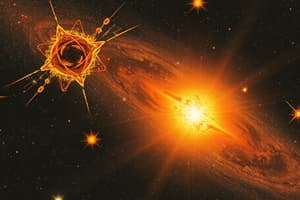Podcast
Questions and Answers
What does 'early/late' refer to in stellar classification?
What does 'early/late' refer to in stellar classification?
- Color
- Size
- Luminosity
- Spectral characteristics (correct)
What is the main sequence in an H-R diagram?
What is the main sequence in an H-R diagram?
A diagonal area that includes more than 90 percent of all stars.
O-type stars are the coolest stars.
O-type stars are the coolest stars.
False (B)
What characterizes a B-type star?
What characterizes a B-type star?
What do A-type stars exhibit?
What do A-type stars exhibit?
An F-type main-sequence star has surface temperatures between _____ K.
An F-type main-sequence star has surface temperatures between _____ K.
What is a G-type main-sequence star also known as?
What is a G-type main-sequence star also known as?
A K-type star is also referred to as a _____ dwarf.
A K-type star is also referred to as a _____ dwarf.
M-type stars can be easily observed from Earth.
M-type stars can be easily observed from Earth.
What is a brown dwarf?
What is a brown dwarf?
Who discovered Wolf-Rayet stars?
Who discovered Wolf-Rayet stars?
What are OB stars characterized by?
What are OB stars characterized by?
Flashcards are hidden until you start studying
Study Notes
Stellar Classification
- Stellar classification categorizes stars based on spectral characteristics and temperature of their photosphere.
- Spectra are generated by splitting a star's electromagnetic radiation, revealing a rainbow of colors with specific spectral lines indicating chemical elements.
- The spectral class of a star summarizes its ionization state, providing an objective measure of temperature.
Main Sequence
- The main sequence is a diagonal band on the Hertzsprung-Russell (H-R) diagram where over 90% of stars are located.
O-Type Stars
- O-type stars have the hottest surface temperatures.
- Their brief lifespan limits the potential for planet formation around them.
B-Type Stars
- B-type main-sequence stars are hydrogen-burning and possess 2 to 16 times the mass of the Sun.
- These stars exhibit surface temperatures between 10,000 and 30,000 K, characterized by a blue hue and prominent neutral helium lines, especially at the B2 subclass.
- Notable examples include Regulus and Algol A.
A-Type Stars
- A-type stars display strong hydrogen absorption lines in their spectra.
F-Type Stars
- F-type main-sequence stars possess 1.0 to 1.4 solar masses and surface temperatures between 6,000 and 7,600 K.
- They give off a yellow-white hue and are also referred to as yellow-white dwarfs.
- Famous examples include Procyon A and KIC 8462852.
G-Type Stars
- G-type main-sequence stars, commonly called yellow dwarfs, have masses of 0.9 to 1.1 times that of the Sun, with effective temperatures ranging from 5,300 to 6,000 K.
- G-type stars undergo hydrogen to helium fusion in their cores; the Sun is a notable example, fusing around 600 million tons of hydrogen every second.
K-Type Stars
- K-type stars, or K dwarfs, are intermediate in size between red M and yellow G stars, with masses between 0.5 and 0.8 solar masses.
- They have lower surface temperatures (3,900 to 5,200 K) and are of interest in extraterrestrial life studies, with Alpha Centauri B being a prominent example.
M-Type Stars
- M-type stars are the smallest and coolest main-sequence stars, known as red dwarfs.
- They are the most common stars in the Milky Way, but due to low luminosity, they are not visible to the naked eye.
- Prominent red dwarfs include Proxima Centauri, the closest star to the Sun.
Brown Dwarfs
- Brown dwarfs are considered "failed" stars, as they lack the mass needed to sustain nuclear fusion.
Wolf-Rayet Stars
- Wolf-Rayet stars were identified in 1867 and include over 220 known examples.
- They possess high temperatures ranging from 25,000 to 100,000 K and lose mass rapidly at over 10^-5 solar masses per year.
- Characterized by wind speeds exceeding 800 to 3,000 km/s, they typically start with masses under 20 solar masses and exhibit no dramatic variability.
OB Stars
- OB stars are hot, massive, early-type stars found in loosely organized groups known as OB associations.
- They have short lifespans, which influences their movement and association in star clusters.
Studying That Suits You
Use AI to generate personalized quizzes and flashcards to suit your learning preferences.




